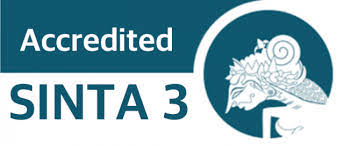LOCAL COMMUNITY PERCEPTION ABOUT THE PLANNING AND DEVELOPMENT OF TOURISM DESTINATIONS IN KEPULAUAN SERIBU REGENCY JAKARTA
Abstract views: 237 | pdf downloads: 526
Abstract
Kepulauan Seribu Administrative Regency, which one of the National Tourism Destinations, continues to transform into a leading tourist area in Indonesia. The development of tourism in this area also has an impact on social and economic life. Planning and developing tourism that does not place the local community as the main actor also affects the understanding of the community. This study tries to identify the local community's perception of the planning and development of Priority Tourism Destinations in the Thousand Islands Regency, DKI Jakarta and the socio-cultural impact of tourism in the area. This study uses data collection techniques through observations at the destination and explores the informants and resource persons. The study results found that public understanding of tourism planning and development in the Thousand Islands Regency is still lacking. This problems arises due to a lack of communication between stakeholders, both central/regional government, private sector and local communities..
References
Acharia, P. (2005). Socio-economic impacts of tourism in Lumbini, Nepal: A case study. Dhaulagiri Journal of Sociology and Anthropology, 1, 193–206.
Andriotis, K. (2006). Hosts, guests and politics: Coastal resort morphological change. Annals of Tourism Research, 33(4), 1079–1098. doi:10.1016/j.annals.2006.04.003.
Alhammad, F. (2012). Residents’ Attitudes towards Tourism Development in AL-Salt City, Jordan. Canadian Social Science, 8(1), 152–163. https://doi.org/10.3968/j.css.1923669720120801.2024
Ap, J. (1992). Residents’ perceptions of tourism impacts. An- nals of Tourism Research, 19, 665–690.
Archer, B., Cooper, C., & Ruhanen, L. (2005). The positive and negative impacts of tourism. Global tourism (3rd ed.). Oxford, England: Butterworth-Heinemann.
Badan Pusat Statistik Kabupaten Kepulauan Seribu. (2021). Kabupaten Kepulauan Seribu Dalam Angka 2021. 335–358. https://doi.org/10.1055/s-2008-1040325
Butler, R. (1980). The concept of a tourist area cycle of evolution: Implications for management of resources. Canadian Geographer, 24, 5–12.
Cohen, E. (1984). The sociology of tourism. Annual Review of Sociology, 10, 373–392.
Deery, M., Jago, L., & Fredline, L. (2012). Rethinking social impacts of tourismresearch: A new research agenda. Tourism Management, 33, 64–73.
Diedrich, A., & García-Buades, E. (2009). Local perceptions of tourism as indicators of destination decline. Tourism Management, 30, 512–521.
Doxey, G. (1975). A causation theory of visitor-resident irritants: Methodology and research inferences. In Travel and Tourism Research Association Sixth Annual Conference Proceedings (pp. 195–198). San Diego, ca: ttra.
Faulkner, B., & Tideswell, C. (1997). A framework for mon- itoring community impacts of tourism. Journal of Sustainable Tourism, 5(1), 3–28.
Jafari, J. (2001). The scientification of tourism. In S. Valene &B. Maryann (Eds.), Hosts and guests revisited: Tourism issues of the 21st century (pp. 28–41).New York, ny: Cognizant Communication Corporation.
Lankford, S. V., & Howard, D. R. (1994). Developing a tour- ism impact scale. Annals of tourism Research, 77(4), 121– 139.
Lowry, L. L. (1994). What is travel and tourism and is there a difference between them: A continuing discussion. New England Journal of Travel and Tourism, 5, 28–29.
Murphy, P. E. (1985). Tourism: A community approach. London, England: Routledge.
Pemerintah Republik Indonesia. (2008). PP No. 26 Tahun 2008 tentang Rencana Tata Ruang Wilayah Nasional. Retrieved February 21, 2022, from https://peraturan.bpk.go.id/Home/Details/4839
Pemerintah Republik Indonesia. (2010). PP No. 50 Tahun 2011 tentang Rencana Induk Pembangunan Kepariwisataan Nasional Tahun 2010 2025. Retrieved February 21, 2022, from https://peraturan.bpk.go.id/Home/Details/5183/pp-no-50-tahun-2011
Pemerintah Provinsi DKI Jakarta. (2014). Peraturan Daerah Provinsi Daerah Khusus Ibukota Jakarta Nomor 1 Tahun 2014 Tentang Rencana Detail Tata Ruang Dan Peraturan Zonasi. Retrieved from https://pelayanan.jakarta.go.id/download/regulasi/peraturan-daerah-nomor-1-tahun-2014-tentang-rencana-detail-tata-ruang-dan-peraturan-zonasi.pdfn
Perez, E. A., & Nadal, J. R. (2005). Host community perceptions: A cluster analysis. Annals of Tourism Research, 32(4), 925–941.
Vargas-Sánchez, A., Porras-Bueno, N., & Plaza-Mejía, A. (2011). Explaining residents’ attitudes to tourism: Is a universal model possible? Annals of Tourism Research, 38(2), 460–480.
Copyright (c) 2022 Jurnal Infrastruktur

This work is licensed under a Creative Commons Attribution-NonCommercial-ShareAlike 4.0 International License.














